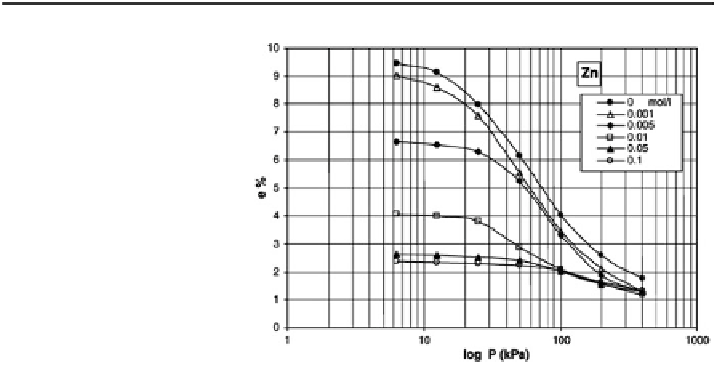Geoscience Reference
In-Depth Information
Table 18.1 Atterberg liquid limits (LL) and plasticity index (PI) as affected by increasing Zn
2+
concentrations in bentonite-heavy metal (nitrate forms) mixtures (Ouhadi et al.
2006
). Reprinted
from Ouhadi et al. (
2006
). Copyright 2006 with permission from Elsevier
Cation type
Atterberg limits
Contaminant concentration (mol/L)
0.005
0.01
0.1
0.5
1.0
Zn
2+
LL
310.9
247.4
121.3
101.9
93.2
PI
274.6
209.9
82.1
57.8
47.4
Fig. 18.4 Consolidation
performance of bentonite
samples, at different
concentrations of Zn2 + in
pore fluid; e denotes void
ratio, and P denotes osmotic
pressure (Ouhadi et al.
2006
).
Reprinted from Ouhadi et al.
(
2006
). Copyright 2006 with
permission from Elsevier
presence of Zn
2+
in pore water causes the formation of a kind of osmotic pressure.
This pressure in turn changes the osmotic equilibrium of the natural system and thus
affects the natural rheological properties of the soil-subsurface system.
Copper (Cu
2+
) application as a micronutrient to agricultural lands, in quantities
greatly in excess of those required by crops, occurs with sewage sludge applica-
tion, and on orchard and vineyard growths when Cu
2+
salts are used as pesticides.
Although there are several potential sources of Cu
2+
applied to soil, Cu
2+
com-
pounds used as pesticides form the largest input. For example, according to
Epstein and Bassein (
2001
), about 3.8 9 10
3
ton of Cu
2+
was used as pesticide in
1997 in California. Copper-induced phytotoxicity has been reported in vineyards,
orchards, and sewage sludge farms after long-term application, and copper pres-
ence was even considered as a potential crop toxicity indicator (McBride
2001
).
Copper salts accumulated in soils after long-term application also have a toxic
effect on soil-subsurface bacterial communities, affecting their enzymatic activi-
ties. In an experiment on tolerance of bacterial communities to long-term copper
application in vineyard soils in Spain, Díaz-Raviña et al. (
2007
) found that
increased soil bacterial toxicity to Cu
2+
was observed at concentrations greater
than 100 mg Cu
2+
/kg soil; copper inhibits enzymatic activities of bacterial com-
munities. Wyszkowska et al. (
2005
) experimented on heavy loamy and sandy silt
loam soils, finding that soil contamination with CuSO
4
5H
2
O at doses ranging
from 150 to 600 mg Cu
2+
/kg inhibited the activity of dehydrogenase, ureases, acid
phosphatases, and alkali phosphatases. Dehydrogenase and urease, which are




